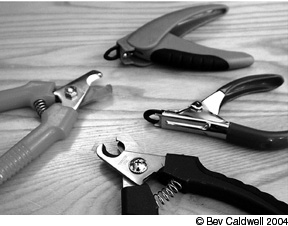The style and the quality of your home furnishings may be a deciding factor when it comes to the regular trimming of your cats claws. Is the beautiful antique sofa you inherited from your grandmother starting to look like so much confetti?

288
Other considerations are your tolerance for discomfort and concern about possible injury. Have you or your children been scratched by a cat scurrying over your head at night? Do you have an elderly person living in your home? This may be the time to consider clipping her claws.
If your cat is house- or apartment-bound and doesnt have a favorite tree on which to stretch and sharpen her claws, or seems to prefer the sofa arm to the carpeted cat scratching post you gave her, clipping her claws frequently is probably a good idea.
It can be done every two to four weeks, advises Jim Richards, DVM, director of Cornells Feline Health Center and editor of CatWatch. It depends on how much you clip off each time.
How to Clip
Its a lot easier if you start getting your cat used to having her claws clipped when she is a kitten. We show owners how to do it from the start, says Dr. Richards, and we pair it with treats. While the owner holds the kitten and gently clips off the ends of the claws, another person feeds the kitten some tasty treats. The result is a kind of Pavlovian training: Over time, the cat associates claw-clipping with receiving tasty morsels to enjoy!
Provide small food treats, says Dr. Richards. You can buy cat treats or small tins of shrimp that you can cut into tiny pieces. The main thing is that it has to be really special, and something that the cat gets only under these particular circumstances.
For older cats that have not had this early training, Dr. Richards suggests that you start by choosing a time when the cat is calm. Never attempt to clip her claws after she has engaged in a lot of stimulating play or has had a stressful encounter. And dont try to calm her by cuddling her and then trying to clip. Wait until the cat has calmed herself down.
The Right Tool
The first step is to get the right instrument for the job. Human fingernail clippers might work, but there are special clippers (both guillotine and shear styles) that are designed specifically for cats and kittens. These can be purchased from pet stores, catalogues or even your veterinarian. Some types even come in stylish colors — but this is obviously more for your enjoyment than for your cat!
As for technique, if you have a dog, you may be used to clipping nails, but the method for cats is different. Cats claws are white and you can easily see where the blood vessels end. Also, the claws of cats are flatter than those of dogs.
To begin with a cat of any age (once the animal is calm), push gently on the pad to help extend the claw. At first, clip just one claw per sitting. With older cats that are not used to having this done, this may take considerable time, perhaps as long as several days, to clip all the toes.
Clip off a little bit at a time and make sure you dont cut into the fleshy part that contains the blood vessels. If your cat really raises a fuss and youre at danger of being seriously scratched, you can also consider the alternative: Take her to a groomer or veterinarian.



